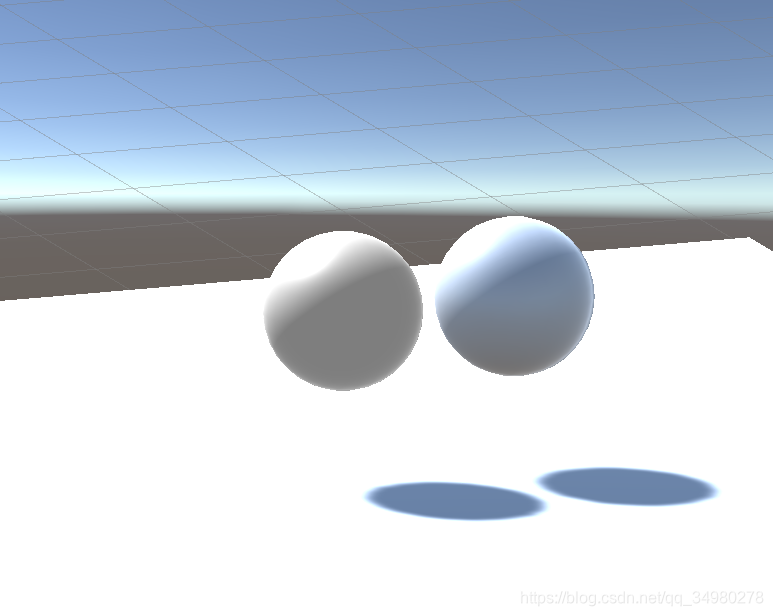参考:http://www.cnblogs.com/wbaoqing/p/9810386.html
https://blog.csdn.net/linuxheik/article/details/78662590
BRDF(双向反射分布函数):光线照到一个物体产生了反射,由于该物体的表面不是理想的镜面,所以光线向各个方向反射(双向反射命名的含义),而且各个方向上的反射强度不同(反射包括漫反射和镜面高光反射),我们以能量的概念来描述这一物理现象,并以某种算法来计算各个现象的权重值,并得到最终的颜色。
Unity中采用基于物理的BRDF模型,核心算法是基于微表面原理的Cook-Torrance BRDF公式
f(l,v)=D(h)F(v,h)G(l,v,h)/(4(n⋅l)(n⋅v));
v——视线方向(从顶点到摄像机的向量)
h——微表面法线
l——光线方向(从顶点到光源的向量)
n——顶点法线
公式可以分解为D、G、F三项计算分别表示漫反射,高光反射和菲涅耳反射(各项的算法参考文件里有,代码注释里也有)
Unity的内置文件UnityStandardBRDF.cginc中BRDF1_Unity_PBS实现了BRDF的效果,本人参考该文件,整理了如下代码:
Shader "Unlit/NewUnlitShader"
{
Properties
{
_Color("Color", Color) = (1,1,1,1)
_MainTex("Albedo (RGB)", 2D) = "white" {}
_Glossiness("Smoothness", Range(0,1)) = 0.5
_Metallic("Metallic", Range(0,1)) = 0.0
_IndirectDiffuseValue("IndirectAiffuseValue",float)=0.5
_IndirectSpecularValue("IndirectSpecularValue",float) = 0.5
}
SubShader
{
Tags{ "RenderType" = "Opaque" "LightMode" = "ForwardBase" }
LOD 100
Pass
{
CGPROGRAM
#pragma vertex vert
#pragma fragment frag
#include "UnityCG.cginc"
#include "Lighting.cginc"
sampler2D _MainTex;
half _Glossiness;
half _Metallic;
fixed4 _Color;
float _IndirectDiffuseValue;
float _IndirectSpecularValue;
struct OutPut
{
fixed3 Albedo;
fixed3 Normal;
half3 Emission;
half Metallic;
half Smoothness;
half Occlusion;
fixed Alpha;
half3 viewDir;
fixed3 lightDir;
};
half DisneyDiffuse_Custom(half NdotV, half NdotL, half LdotH, half perceptualRoughness)
{
half fd90 = 0.5 + 2 * LdotH * LdotH * perceptualRoughness;
half lightScatter = (1 + (fd90 - 1) * Pow5(1 - NdotL));
half viewScatter = (1 + (fd90 - 1) * Pow5(1 - NdotV));
return lightScatter * viewScatter;
}
inline half SmithJointGGXVisibilityTerm_Custom(half NdotL, half NdotV, half roughness)
{
#if 0 //原版(理论基础)
// Original formulation:
// lambda_v = (-1 + sqrt(a2 * (1 - NdotL2) / NdotL2 + 1)) * 0.5f;
// lambda_l = (-1 + sqrt(a2 * (1 - NdotV2) / NdotV2 + 1)) * 0.5f;
// G = 1 / (1 + lambda_v + lambda_l);
//return (2.0f * NdotL * NdotV) / ((4.0f * NdotL * NdotV) * (lambda_v + lambda_l + 1e-5f));
//这里计算了Cook-Torrance的微表面高光BRDF公式的G项和4(nl)(nv)(分母项),还剩D项和F项
half a = roughness;
half a2 = a * a;
half lambdaV = NdotL * sqrt((-NdotV * a2 + NdotV) * NdotV + a2);
half lambdaL = NdotV * sqrt((-NdotL * a2 + NdotL) * NdotL + a2);
return 0.5f / (lambdaV + lambdaL + 1e-5f);
#else //简版(实际使用)
half a = roughness;
half lambdaV = NdotL * (NdotV * (1 - a) + a);
half lambdaL = NdotV * (NdotL * (1 - a) + a);
return 0.5f / (lambdaV + lambdaL + 1e-5f);
#endif
}
inline half GGXTerm_Custom(half NdotH, half roughness)//这里计算D项 D=α²/(π((N·M)²(α²-1)+1)²)
{
half a2 = roughness * roughness;
half d = (NdotH * a2 - NdotH) * NdotH + 1.0f;
return UNITY_INV_PI * a2 / (d * d + 1e-7f);
}
inline half3 FresnelTerm_Custom(half3 F0, half cosA)//这里计算F项 菲涅耳 Schlick公式: Fschlick(v,h)=cspec+(1−cspec)(1−(v⋅h))5
{
half t = Pow5(1 - cosA);
return F0 + (1 - F0) * t;
}
inline half3 FresnelLerp_Custom(half3 F0, half3 F90, half cosA)
{
half t = Pow5(1 - cosA);
return lerp(F0, F90, t);
}
half4 BRDF_Unity_PBS_Custom(OutPut s, half3 specColor, half oneMinusReflectivity)
{
half perceptualRoughness = 1-s.Smoothness; //preroughness
half3 halfDir = Unity_SafeNormalize(s.lightDir + s.viewDir);
half nv = abs(dot(s.Normal, s.viewDir));
half nl = saturate(dot(s.Normal, s.lightDir));
half nh = saturate(dot(s.Normal, halfDir));
half lv = saturate(dot(s.lightDir, s.viewDir));
half lh = saturate(dot(s.lightDir, halfDir));
half diffuseTerm = DisneyDiffuse_Custom(nv, nl, lh, perceptualRoughness) * nl; //漫反射部分D
half roughness = perceptualRoughness*perceptualRoughness;// preroughness²
//---------Cook-Torrance BRDF公式: f(l,v)=D(h)F(v,h)G(l,v,h)/(4(n⋅l)(n⋅v))
half V = SmithJointGGXVisibilityTerm_Custom(nl, nv, roughness);
half D = GGXTerm_Custom(nh, roughness);
half specularTerm = V*D * UNITY_PI;
specularTerm = max(0, specularTerm * nl); //Torrance-Sparrow model,高光部分G
half3 F = FresnelTerm_Custom(specColor, lh);//菲涅耳F
//各部分权重和融合计算
half surfaceReduction = 1.0 / (roughness*roughness + 1.0);
specularTerm *= any(specColor) ? 1.0 : 0.0;
half grazingTerm = saturate(s.Smoothness + (1 - oneMinusReflectivity));
half3 Fidentity = FresnelLerp_Custom(specColor, grazingTerm, nv);
half3 color = s.Albedo * (_IndirectDiffuseValue + _LightColor0.rgb * diffuseTerm)+ specularTerm * _LightColor0.rgb * F+ surfaceReduction *_IndirectSpecularValue *Fidentity;
return half4(color, 1);
}
inline half4 LightingStandard_Custom(OutPut s)
{
s.Normal = normalize(s.Normal);
half3 specColor = lerp(unity_ColorSpaceDielectricSpec.rgb, s.Albedo, s.Metallic);//金属颜色差值
half oneMinusReflectivity=unity_ColorSpaceDielectricSpec.a*(1 - s.Metallic); //unity_ColorSpaceDielectricSpec定义在UnityCG.cginc中
s.Albedo = s.Albedo*oneMinusReflectivity;
half4 c = BRDF_Unity_PBS_Custom(s, specColor, oneMinusReflectivity);
return c;
}
struct v2f
{
float4 pos : SV_POSITION;
half3 worldNormal : TEXCOORD1;
float3 worldPos : TEXCOORD2;
float2 uv:TEXCOORD0;
};
v2f vert(appdata_full v)
{
v2f o;
o.pos = UnityObjectToClipPos(v.vertex);
o.worldPos = mul(unity_ObjectToWorld, v.vertex).xyz;
o.worldNormal = UnityObjectToWorldNormal(v.normal);
o.uv = v.texcoord;
return o;
}
fixed4 frag(v2f i) : SV_Target
{
fixed3 lightDir = normalize(UnityWorldSpaceLightDir(i.worldPos));
fixed3 worldViewDir = normalize(UnityWorldSpaceViewDir(i.worldPos));
//-------配置OutPut结构体
OutPut o;
fixed4 col = tex2D(_MainTex, i.uv)*_Color;
o.Albedo = col.rgb;
o.Metallic = _Metallic;
o.Smoothness = _Glossiness;
o.Normal = i.worldNormal;
o.viewDir = worldViewDir;
o.lightDir = lightDir;
fixed4 c=0;
c+= LightingStandard_Custom(o);
return c;
}
ENDCG
}
}
FallBack"Diffuse"
}
左边是该Shader的效果,右边是StandardShader的效果,少了环境映射,写不动了(TT)。























 3111
3111











 被折叠的 条评论
为什么被折叠?
被折叠的 条评论
为什么被折叠?








